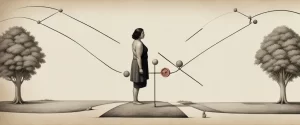
In the realm of creativity and human expression, two distinct disciplines stand out for their immense influence on our perception of the world around us: design and art. While frequently distinguished by their unique characteristics, these disciplines often intertwine, challenging our conventional understanding of their boundaries. This comparative study delves into the works of two iconic authors, Kenya Hara and E.H. Gombrich, who explore the transformative power of design and art, respectively, shedding light on diverse realms of human creativity.
Hara’s “Designing Design” and Gombrich’s “The Story of Art” emerge as pivotal texts that transcend their individual domains to spark a deeper conversation about the connection between design principles and the evolution of art throughout history. Hara, a renowned Japanese designer, examines the dynamics of design, emphasizing its pivotal role in extracting essence, revealing subtle beauty, and driving cultural and societal transformation. Gombrich, on the other hand, presents a comprehensive survey of art history, highlighting the unfolding narratives that shaped its development while providing a profound understanding of the visual arts.
As we embark on an explorative journey, it becomes evident that both works strive to uncover the common threads uniting design and art, transcending mere visual aesthetics. By scrutinizing these texts, we will unravel the profound insights offered by Hara and Gombrich, appreciating the intersections and divergences within their perspectives.
The aim of this comparative study is to critically evaluate the fundamental concepts proposed by Hara and Gombrich, emphasizing the crucial role of design in shaping artistic movements. By synthesizing the distinct viewpoints offered in “Designing Design” and “The Story of Art,” we will uncover how design principles have influenced artistic interpretation and innovation over time.
To achieve a comprehensive analysis, this study will follow a systematic approach, comparing and contrasting key concepts and arguments put forth by Hara and Gombrich. By examining the contexts in which these texts were produced, the influences that shaped the authors’ perspectives, and the underlying philosophies driving their narratives, we will weave together a nuanced understanding of the intricate relationship between design and art.
As we embark on this comparative journey through the works of Kenya Hara and E.H. Gombrich, our goal is to gain a deeper appreciation for the inseparable nature of design and art, recognizing the profound impact these disciplines have on our lives. By merging these perspectives, we hope to unearth valuable insights that foster a greater understanding of the intricate interplay between aesthetics, cultural contexts, and human creativity.
Brief Summary of Two Books
Designing Design by Kenya Hara
Designing Design” by Kenya Hara is a renowned book that explores various perspectives on design, focusing on Japanese culture and aesthetics. Hara, a prominent Japanese designer, introduces readers to his philosophy of design, emphasizing the importance of empty space, simplicity, and the harmony between objects and the environment. The book delves into the concept of “emptiness” as a source of creativity and inspiration, challenging traditional Western notions of design. Through numerous examples and case studies, Hara examines various design elements such as color, form, typography, and signage, providing insights into the essence of Japanese design. Additionally, the book delves into the significance of cultural and societal context in design, as well as the connections between design and traditional Japanese art forms like calligraphy and Zen Buddhism. Overall, “Designing Design” offers a thought-provoking exploration of design principles, cultural influences, and the transformative power of simplicity in the complex world of design.
The Story of Art by E.H. Gombrich
“The Story of Art” by E.H. Gombrich is a widely acclaimed book that provides a comprehensive overview of the history of art from ancient times to the 20th century.
Gombrich takes the reader on a journey through different artistic periods, starting with prehistoric cave paintings and progressing through the art of ancient Egypt, Greece, and Rome. He then explores the artistic developments of the Middle Ages, the Renaissance, and the Baroque era. Gombrich discusses iconic artists such as Leonardo da Vinci, Michelangelo, Rembrandt, and Van Gogh, shedding light on their unique styles and contributions.
The book also delves into the cultural and societal contexts that influenced art throughout history, showcasing the interconnectedness between art, politics, religion, and philosophy. Gombrich’s accessible writing style makes art history approachable to readers of all backgrounds, enabling them to gain a deeper understanding of the significance and evolution of various artistic movements.
Furthermore, “The Story of Art” not only focuses on Western art but also explores the art of other civilizations and cultures, including those of Africa, Asia, and the Americas. This inclusive approach broadens the reader’s perspective and highlights the diversity of artistic expression worldwide.
Overall, through captivating storytelling and insightful analysis, Gombrich’s “The Story of Art” presents a comprehensive and engaging overview of the history of art, making it an indispensable resource for art enthusiasts, students, and curious readers alike.
Comparison between Two Books

Similarities in art history
Both “Designing Design” by Kenya Hara and “The Story of Art” by E.H. Gombrich explore the field of art history and offer insights into various aspects of design and artistic development. While they approach the subject from different angles, there are several similarities in terms of how they depict and discuss art history.
1. Broad Historical Overview: Both books aim to provide a comprehensive historical survey of art, covering a wide range of periods and styles. They present a chronological narrative that traces the evolution of art from ancient civilizations to contemporary times. Hara and Gombrich both highlight key milestones and influential figures in art history.
2. Global Perspective: Both authors take a global perspective, acknowledging and examining art from different parts of the world rather than focusing on a single cultural or geographical area. They emphasize the interconnectedness of artistic developments across diverse cultures and regions, demonstrating how art has evolved through cross-cultural influences.
3. Multidisciplinary Approach: Hara and Gombrich acknowledge that art history cannot be studied in isolation and integrate various disciplines into their interpretations. They draw on fields such as philosophy, psychology, anthropology, and sociology to analyze and understand the context, meaning, and impact of different artistic movements and artworks.
4. Focus on Meaning and Function: Both authors investigate the underlying meanings, intentions, and functions of art throughout history. They emphasize that art is not solely an aesthetic or decorative endeavor but often serves as a reflection of societal, cultural, and political contexts. Hara and Gombrich explore how art can be a powerful tool for communication and expression.
5. Emphasis on Design Principles: While “The Story of Art” presents a traditional art historical perspective, “Designing Design” focuses on contemporary design and its relationship with art. Despite this difference, both books discuss design principles and the role of aesthetics, materials, and techniques in creating impactful artwork. They explore the balance between form and function and how design elements contribute to the overall artistic experience.
6. Visual Documentation: Both books feature high-quality visual documentation of artworks, providing readers with visual references for the discussed art movements, styles, and individual works. This visual component enhances the reading experience and enables the readers to gain a deeper understanding of the concepts and artwork being discussed.
In summary, “Designing Design” by Kenya Hara and “The Story of Art” by E.H. Gombrich share similarities in their approach to art history. Both books provide a comprehensive historical overview, take a global perspective, employ a multidisciplinary approach, emphasize the meaning and function of art, discuss design principles, and offer visual documentation.
Divergences in art history
Designing Design by Kenya Hara and The Story of Art by E.H. Gombrich are two notable books that explore different aspects of art history. While both books aim to shed light on the world of art, they diverge in their approach, content, and focus.
One of the primary divergences between the two books is their approach to art history. The Story of Art by E.H. Gombrich takes a more linear and comprehensive approach, covering a wide range of art history from prehistoric cave paintings to contemporary art. Gombrich provides an extensive overview of various art movements, artists, and their contributions, emphasizing the evolution and progression of art through time.
On the other hand, Designing Design by Kenya Hara takes a more focused and contemporary approach to art and design. Hara, being a renowned graphic designer himself, delves into the philosophy and principles of design, providing a fresh perspective on how design connects with culture, society, and human experiences. His book often explores Japanese aesthetics and design sensibilities, making it a more specialized and niche work in comparison to Gombrich’s broad-ranging coverage.
Another divergence lies in the content and emphasis of the books. The Story of Art emphasizes the narrative of art history, focusing on the historical context, major artistic movements, and notable artists. It analyzes the development of different art forms and explores the underlying motivations behind various art movements. Gombrich’s book aims to provide a comprehensive understanding of art history as a whole.
In contrast, Designing Design places greater emphasis on the philosophy and conceptual aspects of design in relation to culture and society. Hara explores themes such as emptiness, imperfection, and simplicity, drawing on Japanese traditions and aesthetics. His book encourages readers to question the role of design in shaping our lives and the significance of aesthetic experiences.
In conclusion, while both Designing Design by Kenya Hara and The Story of Art by E.H. Gombrich touch upon art history, they approach the subject from different angles. Gombrich’s book offers a more traditional and comprehensive overview of art history, while Hara’s book focuses on contemporary design principles and their cultural implications. Both books offer unique insights into the world of art and design, catering to different interests and perspectives.

Conclusion
Both Designing Design by Kenya Hara and The Story of Art by E.H. Gombrich are highly regarded books in their respective fields. The choice between the two ultimately depends on your specific interests and what you are looking to gain from reading.
Designing Design by Kenya Hara is a book focused on design theory, aesthetics, and the philosophy behind design. It offers insights into Hara’s experiences as a designer and provides a deep exploration of the role of design in society and culture. This book is particularly valuable for those interested in the world of design, creativity, and the thought process behind innovative design solutions.
On the other hand, The Story of Art by E.H. Gombrich is a comprehensive survey of the history of art. It covers a wide range of periods and styles, from ancient civilizations to modern art movements. Gombrich’s book is highly accessible, making it suitable for both art novices and enthusiasts alike. It offers a balanced perspective on art history, discussing major artists, their works, and the socio-historical context in which they were created.
If you are primarily interested in design and its philosophical aspects, Designing Design by Kenya Hara may be the more fitting choice for you. However, if you are looking for a broad understanding of art history from a renowned expert, The Story of Art by E.H. Gombrich may be the more suitable option.
In the end, both books offer valuable insights into their respective subjects and are highly recommended readings in their fields. It might also be worth considering your own personal interests and goals to make a more informed decision.



